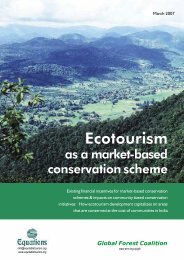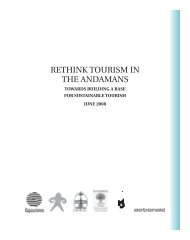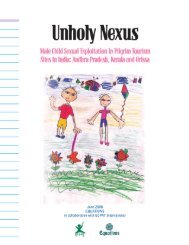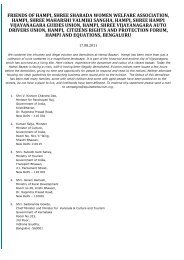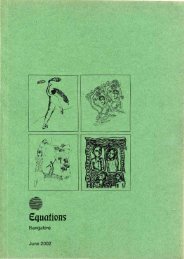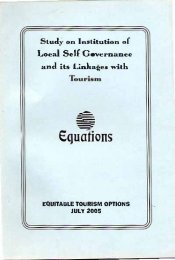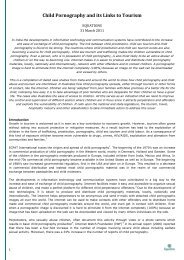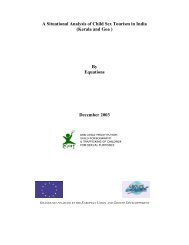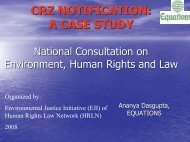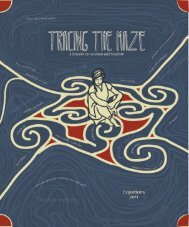Nilgiris Biosphere Reserve - Equitable Tourism Options
Nilgiris Biosphere Reserve - Equitable Tourism Options
Nilgiris Biosphere Reserve - Equitable Tourism Options
You also want an ePaper? Increase the reach of your titles
YUMPU automatically turns print PDFs into web optimized ePapers that Google loves.
up huts was the homeland of different adivasi communities in Wayanad<br />
such as the Paniyas. the Vetta Kurumas, the Kattunaikkas. the Adiyas and<br />
the Mullukuruma etc. Our sacred groves and burial grounds still exist in<br />
Muthanga. Several adivasi families had been forcibly evicted from<br />
Muthanga during 1970s and '80s, first while declaring the area as a<br />
sanctuary and then for establishing the eucalyptus plantations. Those who<br />
were evicted were compelled to live a wretched life in several tribal<br />
'colonies' where starvation deaths were rampant.<br />
The adivasi families who entered the forestland had only sought to assert<br />
the traditional right over the Muthanga forests. They erected huts in the<br />
barren area and reorganised the Adivasi Oorukootams (hamlet-level selfgovernment<br />
institution). Along with subsistence agriculture, we re-started<br />
our gothra pooja (collective ritual worship). A minimum programme for Self<br />
Rule in accordance with the spirit of the Panchayats (Extension to the<br />
Scheduled Areas) Act, 1996 was drawn up. The regeneration of the ecosystem,<br />
primarily the water sources and the vegetation was an important<br />
objective in this. The Adivasi Oorukootams reorganised in the Muthanga<br />
were determined to achieve this through community management and the<br />
application of traditional knowledge. We were convinced that there was no<br />
need for huge donor agency funds for achieving this objective.<br />
At no point during the struggle in Muthanga, did the Govt. authorities<br />
conduct a discussion with the protestors. The authorities never issued any<br />
notice in accordance with eviction procedures. The police or the District<br />
Collector did not gather any information from us. Throughout the AGMS<br />
occupation of Muthanga, the Forest Department, however, resorted to<br />
unlawful and covert means to evict the adivasis. Twice they sent<br />
domesticated elephants fed with alcohol to attack the adivasi huts. On two<br />
occasions, some unknown persons, obviously hired by the Forest<br />
Depa rtment, set fire to the forests and the grassland.<br />
All the authorities, and a few fake conservationists with vested interests,<br />
concealed the truth regarding the actual status of the Muthanga forest and<br />
the indigenous people who had a right over it. Instead, they churned out<br />
false reports claiming that Muthanga was the breeding ground of elephants<br />
and a core area of the sanctuary. Most of the biodiversity of Muthanga had<br />
been sucked dry by a parallel economy that thrived on illegal ivory and<br />
sandalwood trade that went on unabated with the connivance of the Forest<br />
Nilagiris : Fading Glory 76



